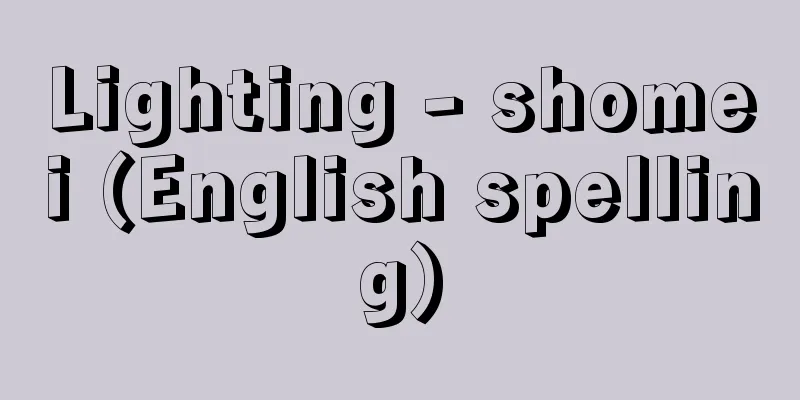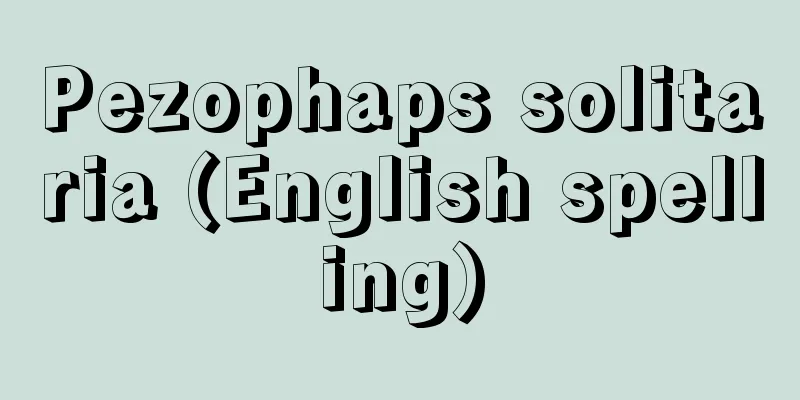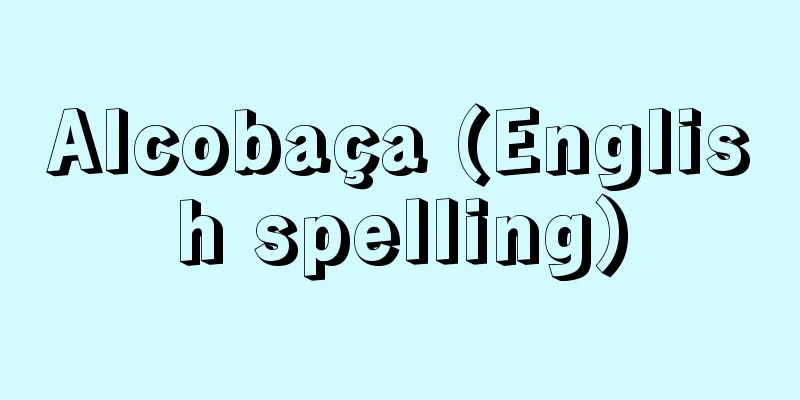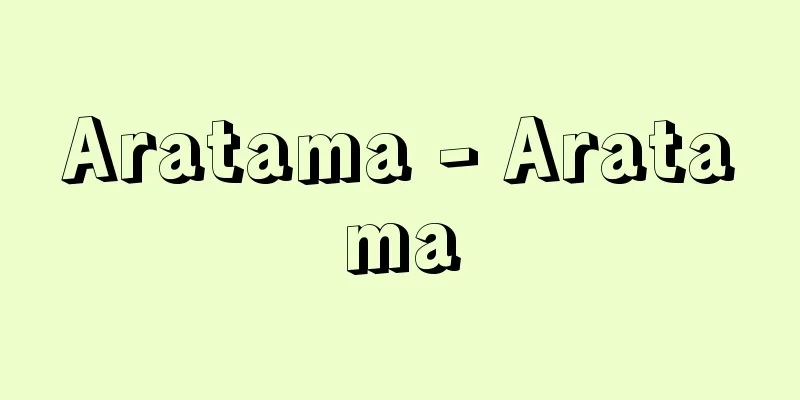Lighting - shomei (English spelling)

|
It refers to illuminating an object or place with light, and making the light source itself visible, such as a traffic light. Humans have a superior sense of vision, but lighting is necessary for this to function. [Takashi Azuma and Sadao Takahashi] Daylighting and artificial lightingLighting can be broadly classified into daylight and artificial lighting based on the type of light source. [Takashi Azuma and Sadao Takahashi] DaylightingIn nature, there is light from the sun, the moon, stars, bioluminescence, and other sources. However, the sun is the only source that can be used as an illumination source, and this is called daylight. Daylight can be divided into three types: direct sunlight, skylight, and light reflected from objects. Direct sunlight is sunlight that passes through the atmosphere and reaches the earth's surface directly, while skylight is light that is scattered and absorbed by molecules, dust, and other particles in the atmosphere as it passes through the atmosphere, and this scattered light reaches the earth's surface. Light reflected from the ground or outdoor objects is called light reflected from objects. Let us now look at the temporal changes in daylight illuminance observed in Osaka on three typical weather conditions (clear, clear with clouds, and overcast). The illuminance of direct sunlight is stable and high on clear days (it can reach 100,000 lux at midday in midsummer), but fluctuates irregularly on cloudy days due to the influence of clouds, and is almost zero on cloudy days. The illuminance of skylight remains at around 10,000 lux for about seven hours on clear days, and remains relatively stable at higher illuminance on cloudy and overcast days. The light reflected from ground objects changes in a complex manner because it is affected by the reflective properties of ground objects in addition to the input sunlight, but the illuminance value is about one-tenth of the skylight illuminance, and is considered to be at most 1,000 lux. When working indoors using daylight lighting, the only light you can rely on is the combination of skylight (excluding direct sunlight) and the light reflected from ground objects. Daylight enters a building through windows. There are two types of windows: side windows (normal windows in vertical walls) and skylights (horizontal windows in the roof). The size of side windows is regulated by the Building Standards Act, which stipulates that in the case of residences, the ratio of the area of the part effective for daylighting to the floor area of the occupant room must be at least one-seventh. For other buildings, the "ratio" must also be at least the value shown in . Even if you try to make use of daylight as described above, the illuminance of daylight is insufficient on rainy days, in the evening, or more than 3 to 4 meters from the window, so indoor work cannot be carried out by daylight alone and it becomes necessary to add artificial lighting to compensate for the drop in illuminance. [Takashi Azuma and Sadao Takahashi] Artificial lightingLighting from artificial light sources is called artificial lighting. Most artificial light sources give off a stable light, making it possible to design lighting with confidence. Artificial lighting has made remarkable advances to date, and lighting is now found everywhere, including homes, buildings, roads, and squares. As a result, the scope of human life has expanded greatly in both time and space. The following will focus on artificial lighting. However, for a historical description of "humanity and light," please refer to the "Light" entry. [Takashi Azuma and Sadao Takahashi] Transition of light sourcesThere are two phenomena that produce light: thermal radiation and luminescence. These can be further subdivided into thermal radiation, which is combustion, which oxidizes an object, and incandescence, which heats an object to a high temperature in a container from which the air is excluded, and luminescence, which is discharged in a gas and luminescence emitted by solids and liquids. First, looking at "combustion," early humans are said to have started using fire 500,000 years ago (one theory is that it was 1.4 million years ago), but progress was slow, and oil lamps using bio-oil appeared about 10,000 years ago. Candles were invented in Japan around 720, and oil lamps (1859) and gas lamps (1872) were introduced as Western-style lamps. "Incandescent" itself is the history of the incandescent light bulb. It began with the invention of the vacuum light bulb using a carbon filament by Edison in 1879, followed by the change in filament to tungsten, and the development of many different types of incandescent light bulbs based on major inventions such as the gas-filled single coil bulb, the double coil bulb, the bulb with a frosted interior, and the halogen bulb. In terms of "electric discharge," the Dubosc arc lamp, which used an arc in air, was first developed in 1855, and in terms of low-pressure discharge, neon glow lamps were followed by low-pressure sodium lamps. In terms of high-pressure discharge, high-pressure mercury lamps were followed by fluorescent high-pressure mercury lamps, and then metal halide lamps and high-pressure sodium lamps appeared, which led to the prosperity of HID lamps (short for high intensity discharge lamps). Fluorescent lamps have also made great strides since the invention of a practical fluorescent lamp by General Electric of the United States in 1938, and have come in a wide variety of shapes, including rod-shaped, ring-shaped, U-shaped, flat, and globe-shaped, as well as light color, color rendering, and size. In particular, fluorescent lamps have become more compact and thinner, and in 1980 (Showa 55), compact bulb-shaped fluorescent lamps with the same base as incandescent light bulbs were commercialized, followed in 1991 (Heisei 3) by highly efficient high-frequency-only fluorescent lamps with a tube diameter of 25.5 mm (called Hf fluorescent lamps), which were significantly more efficient than light bulbs and conventional rod-shaped fluorescent lamps (tube diameters of 32.5 or 28 mm), and helped to save energy for lighting. In the early 1990s, long-life electrodeless fluorescent lamps and electrodeless HID lamps appeared. The progress of these light sources was largely due to the small, thin, lightweight, highly efficient electronic ballasts used to light the light sources. In the field of "solid and liquid light emission," following EL lamps (electroluminescence), light-emitting diodes (LEDs) appeared in 1962. White LED lamps were then released and began to be used for lighting in addition to displays. Since the invention of the ruby laser in 1959, many types of lasers have been developed, including solid, liquid, gas, and semiconductor lasers. To sum up, today's light source world consists of three pillars: incandescent lamps, fluorescent lamps, and HID lamps, each of which is diverse in size, shape, and special performance, allowing you to freely choose a light source that suits your lighting purposes. [Takashi Azuma and Sadao Takahashi] Lighting MethodThe way lighting is provided is called the lighting system. This is a technical term that applies to artificial lighting, and it can be divided into the following four systems depending on the position and arrangement of the lighting fixtures. [Takashi Azuma and Sadao Takahashi] General lighting methodA lighting method that creates a relatively uniform horizontal illuminance of a certain value by arranging multiple lighting fixtures regularly on the ceiling or other surface. This is the most common lighting method because it provides a nearly uniform illuminance throughout the entire room. There are the following types of this method: (1) Recessed type (continuous rows of fluorescent lamps, downlights such as light bulbs, etc.)
[Takashi Azuma and Sadao Takahashi] Local lighting methodThis is a method of illuminating the target work area with additional lighting equipment from a relatively short distance away so that illuminance is only provided to the work area. Lighting may be supplemented for tasks such as drafting or inspecting small objects, but this can also be called local lighting. Local lighting is recommended for the following work conditions: (1) Ultra-precision work where high illumination is required only in the work area. (2) The task of observing shape and texture using strong, directional light. (3) Where there should be no general lighting. (4) When you want to improve the poor visibility caused by reduced luminance contrast due to general lighting. [Takashi Azuma and Sadao Takahashi] Localized general lighting methodThis is a method of mainly illuminating a part of the work area as an alternative to general lighting using a regular arrangement of lighting fixtures. This was devised from the perspective of rational use of lighting energy, and only the area where work is done is illuminated with high illuminance, while other areas are generally illuminated with about half to one third of that illuminance. By clearly separating and lighting the work area from its surroundings, the illuminance of areas that are not very important for work can be reduced, and lighting energy can be rationalized. [Takashi Azuma and Sadao Takahashi] Task/ambient lighting methodTask and ambient lighting methods have been used since around 1980 for the reasons of energy saving and personalization (the ability to freely adjust the brightness or blinking of lighting to suit one's personal preferences). A specific work surface (such as a desk) is lit with task lights (task means work, and in lighting it means visual work. Task lights are lighting fixtures for visual work), and the surrounding area (ambient) is lit with indirect lighting that is half to one-third the illuminance of the task lights. It is sometimes abbreviated as TAL (task and ambient lighting). Compared to general lighting methods, the distribution of brightness in a room is non-uniform, lighting is individually controllable, and it is easy to create workstations using partitions. The lighting methods mentioned above are classified according to the difference in the way illuminance is given to the space, but there is a lighting method called architectural lighting that is based on the relationship between lighting and architecture. In this method, the ceiling and walls are prepared for lighting in advance, and the lighting fixtures that serve as the light source are built inside the architectural structure so that they are not visible. The light emitted from architectural lighting into the room hits the ceiling and walls first, so it becomes indirect light, making the space feel soft and calm. However, it is difficult to direct the light to the desired location, and it is more suitable for creating an atmosphere in a space or combining it with other light sources to create a space, rather than for viewing objects. The main methods are light ceilings, raised ceilings, and cove lighting for lighting the ceiling surface, and balanced lighting, cornice lighting, and wall brackets for lighting the walls. Compared to general lighting methods in which normal lighting fixtures are installed independently, architectural lighting is superior in terms of glare control, spatial distribution of light, and visual beauty. In addition, floodlighting is used to light baseball stadiums and other large outdoor sports facilities. This uses floodlights to provide sufficient illumination to the playing surface, and although it is a localized lighting system, it is considered to be a type of lighting technique. [Takashi Azuma and Sadao Takahashi] Lighting MethodWhile the lighting system refers to the arrangement of lighting fixtures in relation to the illuminance distribution in a room, the lighting method refers to the way in which light is directed at the place or task to be illuminated. Since the way in which light is directed is determined by the light distribution of the lighting fixture, it is often referred to as a way of classifying the light distribution of lighting fixtures. Lighting methods are broadly divided into direct lighting and indirect lighting, each with its own characteristics, and intermediate methods include semi-direct lighting, general diffuse lighting, and semi-indirect lighting. [Takashi Azuma and Sadao Takahashi] Direct lightingLighting using fixtures with a light distribution that allows 90-100% of the divergent light flux to reach the work surface directly. It is effective in obtaining illuminance, but attention must be paid to the angle of the line of sight in terms of glare. Generally produces strong shadows. [Takashi Azuma and Sadao Takahashi] Indirect lightingLighting using fixtures with a light distribution such that 10% or less of the emitted luminous flux reaches the work surface directly. The remaining 90-100% of the luminous flux is emitted upwards, reflecting once off the ceiling or the upper part of the wall before reaching the work surface indirectly. The efficiency of this lighting method is governed by the reflectance of the ceiling, etc., and is generally low. However, there is little glare and no harsh shadows. [Takashi Azuma and Sadao Takahashi] Semi-direct lighting, general diffuse lighting, semi-indirect lightingThese refer to lighting using fixtures in which the proportion of downward luminous flux is 60-90%, 40-60%, and 10-40% of the divergent luminous flux, respectively. The above classification of lighting methods was very significant in the days when only incandescent lighting was available, but nowadays, fluorescent lights are widely used in addition to incandescent bulbs, and diffuse lighting can be achieved using fluorescent lamps alone, so the classification is no longer as significant. [Takashi Azuma and Sadao Takahashi] Lighting PlanLighting planning is the process of considering and designing lighting that is appropriate for a building or place. The purpose of lighting is determined by the purpose of the space and the desires of the people who live and act there. The first step in lighting planning is to consider the desired visual environment based on these subjective desires. A desirable visual environment can be achieved by ensuring visual workability (being able to see what you are trying to see quickly and clearly) and visual comfort in general, and by striking a balance between the two. Next, we consider the illuminance, reflectance, light color and color rendering of the lighting source, the degree of glare, shadows, etc. This type of consideration is called the consideration of lighting elements. In addition to considering lighting elements, we also consider the spatial composition, such as the interior design and color plan, and strive for harmony with things closely related to lighting, and we give careful consideration to the appearance of the space as a whole, as well as the appearance and atmosphere of each part. The lighting method is selected based on these considerations. The lighting method involves considering the type of light source and the light distribution of the lighting fixtures, and then drawing out the arrangement of the lighting fixtures. At this time, the relationship with air conditioning, disaster prevention, and emergency facilities must also be taken into consideration. Lighting calculations are performed to see if the required illuminance and lighting effect can be obtained with the selected lighting fixtures and arrangement. As a result of the calculations, any necessary modifications are made and the lighting plan is finalized. If it is difficult to estimate the lighting effect, partial lighting experiments, lighting experiments using a scale model, or lighting simulations using computer graphics are used. Calculations of the installation costs of the lighting equipment and operating costs including maintenance are also included in lighting plans in the broad sense. [Takashi Azuma and Sadao Takahashi] Lighting in PracticeLighting can be broadly divided into clear light, production light, and commercial light based on the purpose, but it can also be divided into residential light, office light, etc., based on the target location. However, it is meaningless to make such a strict distinction between the two, and as mentioned above, they can also be broadly divided into daylight lighting and artificial lighting. [Takashi Azuma and Sadao Takahashi] Clear Vision LightingLighting that provides good visibility for visual work. Lighting in offices, school classrooms, libraries, etc., falls into the category of clear vision lighting. When visual display devices (visual display terminals, or VDTs) for office automation equipment are installed in an office, the horizontal illuminance is about 750 lux, roughly the same as for conventional desk work, but lighting fixtures that strictly limit luminance at vertical angles of 60 degrees or more are often used to prevent a reflected image of the lighting fixture from appearing on the VDT's CRT screen. In clear-vision lighting, there must be no glare from the lighting source. There are two types of glare: impaired vision glare, which impairs visibility, and discomfort glare, which allows you to see things but causes discomfort. In offices and other places, it is important to prevent discomfort glare from fluorescent lighting. The level of discomfort glare should be calculated at the lighting design stage, and lighting fixtures appropriate for the room should be selected. In places such as libraries where harmony between task lighting and ambient lighting is required, task lighting is provided by fluorescent task lights attached to the desks, providing 500 lux, while ambient lighting is provided by indirect fluorescent lighting, creating a soft, calming atmosphere. [Takashi Azuma and Sadao Takahashi] Production LightingLighting that helps improve productivity, reduces accidents, including safety, and improves quality. Factory lighting is an example of this. In factories, HID lights are generally used above a ceiling height of 5 meters, and fluorescent lights are generally used below that. HID lights have a large luminous flux per lamp, so fewer lamps are needed, which saves energy. In addition to improved productivity, the effects of improved illuminance include improved quality and fewer accidents. Product inspection is essential at production sites, and is automated by machines, but difficult inspections such as finding product flaws or foreign matter contamination, and judging grades are often done with the naked eye. With inspection lighting, ergonomic considerations are required, and careful consideration must be given to the illuminance, light color, color rendering, light directionality, and light application method for each inspection object. [Takashi Azuma and Sadao Takahashi] Commercial LightingIn the case of commercial lighting, lighting is considered part of the sales expenses. Therefore, as one of the sales promotion measures, lighting plans do not only include product display lighting, but also include the spatial composition in the plan. Commercial lighting in stores generally consists of lighting that displays products at high intensity, and general lighting for the store. Since the late 1980s, light sources that combine halogen bulbs with an infrared reflective film and reflectors with an infrared absorbing film have been used for commercial display lighting. This significantly reduces the amount of lighting heat generated by lighting, and is effective for lighting pearls, cloth, fresh food, and other items that are sensitive to heat rays. General lighting in a store is often installed as part of the architecture. [Takashi Azuma and Sadao Takahashi] Residential LightingThe role of residential lighting is to provide two types of lighting: lighting necessary for seeing things and lighting for creating the atmosphere of a room. Illuminance is important for seeing things, but the atmosphere is not only affected by illuminance, but also by the color of light that brings out the colors of the room's interior and furniture, color rendering, the direction of light, the brightness of the interior surfaces, and the sparkle of light like a chandelier. Choose lighting fixtures and their installation positions carefully according to the residents' preferences. There are three basic lighting methods: basic lighting that illuminates the entire room, localized lighting that illuminates only a part of the room for a certain activity such as reading, and accent lighting that illuminates decorative items such as paintings. Lighting fixtures for basic lighting include ceiling lights (fixtures directly attached to the ceiling) and pendants (hanging ceiling lights), both of which come in Japanese and Western styles. Select one of them according to the style of the room. Elderly people have poorer visual function than younger people, so they need good quality lighting without glare. In particular, lighting fixtures should be installed so that steps in corridors, stairs, bathrooms, entrances, etc. can be clearly seen, and the necessary illuminance should be maintained. [Takashi Azuma and Sadao Takahashi] Art lightingOne of the characteristics of a museum is that the entire exhibition space is either dark or bright. This creates a unique atmosphere for the museum. However, even if it is dark, the exhibits are lit by halogen spotlights and are designed to be clearly visible in detail. In addition, bright museums have interior finishes with light-colored fluorescent lighting, which has the effect of reducing fatigue from viewing the works as much as possible. In the 1990s, hybrid museums appeared, where individual exhibition rooms are dark and large exhibition spaces, lobbies, and entrances are bright. Daylight is an excellent light source, but the heat and ultraviolet rays contained in daylight deteriorate artworks. Removing these rays is not easy. For this reason, artificial lighting with light sources with high color rendering properties is widely used. In many cases, relatively small paintings and sculptures are lit with light sources that cut heat and ultraviolet rays, and large paintings are lit with fluorescent lighting fixtures with louvers that prevent fading. In order to prevent the temperature inside the case from rising, a method is also used to light the display cases by installing light sources outside the case and guiding the light into the case with quartz fiberglass. The appreciation of art (high illumination to make it easier to see) and preservation (low illumination to prevent deterioration) are mutually exclusive requirements for lighting, and finding a compromise between the two requires very important and careful consideration. [Takashi Azuma and Sadao Takahashi] DaylightingTaking in daylight through windows is called daylighting design, and has been emphasized since ancient times. Taking in natural daylight is irreplaceable, but at the same time, it satisfies the sense of openness and views that connect the outside world with the inside of a building. In terms of the relationship between windows and daylighting, side window lighting is the norm, but since the 1980s, atriums (courtyards) with skylights have been installed in buildings such as skyscrapers, and attempts to create fresh spaces have become more common. To estimate the illuminance (brightness) of a room caused by daylighting, the design sky illuminance and the reference daylight factor are used. The design sky illuminance is the ground level illuminance determined to predict the degree of daylighting in a room, and is divided into six categories: a bright day = 50,000 lux (unit symbol lx), a bright day = 30,000 lux, a normal day = 15,000 lux, a dark day = 5,000 lux, a very dark day = 2,000 lux, and a clear blue sky = 10,000 lux, under conditions where there is nothing blocking the light outdoors. The reference daylight factor is determined for each type of work and room, for example, 2% for a reading room or a normal classroom. Then, under conditions of a sky illuminance of 15,000 lux on a normal day, the indoor illuminance from natural lighting alone is estimated to be 300 lux (= 15,000 * 0.02). Although a minimum of 300 lux is not enough, it is possible to read or work in the classroom. The standard daylight factor is an index of the minimum illuminance required to be obtained on an average day with natural lighting alone, without artificial lighting. [Takashi Azuma and Sadao Takahashi] FloodlightsFor nighttime lighting in baseball stadiums and other venues, floodlighting systems using HID floodlights are used. The aim of the floodlights is determined so as not to create large unevenness in the illuminance on the playing surface and not to cause glare to the players. In baseball stadiums and soccer stadiums where color television broadcasts are made, high-output, white metal high-light lamp floodlights with excellent color reproduction for television images are used. [Takashi Azuma and Sadao Takahashi] Highway lightingJapan's first full-scale expressway lighting was introduced after the opening of the Meishin Expressway in 1963 (Showa 38). At the time, fluorescent mercury lamps and low-pressure sodium lamps (for tunnel lighting) were used as light sources. Later, with the advancement of HID light sources, high-pressure sodium lamps, which have higher lamp efficiency, came to be adopted. The high-pressure sodium lamp lighting of the Innoshima Bridge, one of the bridges connecting Honshu and Shikoku, completed in 1983, limits the light distribution so that the light does not fall on the sea surface, out of consideration for the impact on the marine ecosystem. [Takashi Azuma and Sadao Takahashi] Airport LightingAmong the lighting facilities at airports, approach lights, runway lights, and taxiway lights (lights that guide aircraft to designated locations) are visual aids for pilots, and international performance standards are established for them. Halogen bulbs and xenon flash lamps are used as light sources. Apron lights consist of multiple HID floodlights attached to light poles 15 to 30 meters high for passenger boarding and disembarking and for loading and unloading of cargo. [Takashi Azuma and Sadao Takahashi] Landscape lightingLandscape lighting is used to beautifully illuminate buildings in cities and towns. The advantage of landscape lighting is that it adds beauty to streetscapes and creates attractive nighttime scenery, but it also helps revitalize and create an image of the city or region, and is useful for tourism and crime prevention. However, excessive lighting can cause glare that mars the beauty of the area, or make the sky too bright, which defeats the purpose. The negative side of such lighting is called light pollution. Landscape lighting is used for landmarks, historical buildings, shrines and temples, public buildings such as bridges and towers, commercial and industrial buildings, and trees. Famous examples include the Rainbow Bridge over Tokyo Bay, Tokyo Tower, Kinkakuji Temple in Kyoto, and Osaka Castle. There are two methods of landscape lighting: floodlighting and illumination (electric decorations = decorations made with electric light). For example, when lighting a bridge, floodlights are used on the main tower and piers, and electric decorations are used on the cables. These two methods are completely different, but what they have in common is that they are not more extravagant than necessary. In addition, energy waste caused by emitting light unnecessarily must be avoided. The term "light up" is used to refer to floodlighting of buildings at night. Illuminance is a measure of the performance of lighting facilities, and is established as an illuminance standard in the Japanese Industrial Standards (JIS). In addition, "Lighting for indoor workplaces" was established as an international standard (ISO = International Organization for Standardization) in 2002. [Takashi Azuma and Sadao Takahashi] Lighting and colorLighting and color are closely related, and lighting plays a large role in bringing out the effects of color. The characteristic of making colors appear faithful is called color rendering, and the average color rendering index (Ra) is used as a measure of the color rendering of a lighting source. The higher the average color rendering index, the better the color rendering. The maximum value is 100. For color examinations and clinical treatments where color appearance is important, and for appreciation of artworks, a Ra of 90 or more is recommended; for offices, homes, restaurants, stores, schools, hospitals, printing and painting factories, etc., a Ra of 80 to 90 is recommended; for general factory work, a Ra of 60 to 80 is recommended; for relatively low-light work areas and warehouses, a Ra of 40 to 60 is recommended; and for indoor and underground parking lots, a Ra of 10 to 40 is recommended. [Takashi Azuma and Sadao Takahashi] Energy saving lightingThe following seven items are effective measures for saving energy in lighting: (1) Adoption of highly efficient light sources [Takashi Azuma and Sadao Takahashi] になったんです。 English: The first thing you can do is to find the best one to do .になったんです。 English: The first thing you can do is to find the best one to do .になったんです。 English: The first thing you can do is to find the best one to do. Design』(2000・建築資料研究社)』 [Reference Items] | | | | | | | | | | | | | | | | | | | | | | | | Lamp | | | | | |©Shogakukan "> Regulations regarding window area for daylight illumination [Table] ©Shogakukan "> Classification of lighting fixtures by light distribution Source: Shogakukan Encyclopedia Nipponica About Encyclopedia Nipponica Information | Legend |
|
物体や場所を光で照らすこと、および信号灯のように光源そのものを見せることをいう。人には視覚という優れた知覚があるが、これを働かせるためには照明が必要である。 [東 尭・高橋貞雄] 昼光照明と人工照明照明を光源の種類で大別すれば、昼光照明と人工照明とになる。 [東 尭・高橋貞雄] 昼光照明自然には太陽、月、星、生物発光などの光がある。しかし、照明光源として使えるのは太陽だけといってよく、これを昼光とよぶ。昼光は、直射日光、天空光および地物反射光の三つに分けて考えられる。太陽光が大気圏を透過して直接地表に到達するものを直射日光といい、大気圏を通過中に大気中の分子・塵(ちり)などの微粒子によって散乱・吸収を受け、その散乱光が地表に到達するものを天空光という。また、太陽光が地面や屋外の物体から反射して照明光になるものを地物反射光という。 ここで三つの典型的な天候(快晴、雲のある晴れ、曇天)の日において、大阪で観測された昼光照度の時間的変化をみてみよう。直射日光の照度は快晴日に安定して高い値(真夏正午に10万ルクスに達する所もある)を示し、雲晴日(うんせいび)には雲の影響で不規則に変動し、曇天日にはほとんどゼロになる。天空光による照度は、快晴日には1万ルクス前後を7時間程度保っており、雲晴日、曇天日には、もっと高い照度を比較的安定に続けている。地物反射光は、入力である太陽光のほかに地物の反射性状が影響するために複雑に変化するが、照度値は天空光照度の10分の1程度で、せいぜい1000ルクスとみなされる。昼光照明で屋内作業をする場合は、直射日光を除いた天空光と地物反射光をあわせた光だけが頼りになる。 昼光は窓を通して建物内へ採光される。窓には側窓(鉛直壁にある普通の窓)と天窓(屋根面にある水平な窓)とがある。側窓の大きさについては建築基準法の規定があって、住居の場合、採光に有効な部分の面積の、その居室の床面積に対する割合が7分の1以上であるように決められている。その他の建物についても、「割合」がに掲げた値以上でなければならない。 以上のように昼光利用に努めても、雨天、夕方とか、窓際から3~4メートル以上の奥では昼光照度が不足するから、屋内作業を昼光だけで行うことができず、人工照明を加えることによってその照度低下を補う必要が出てくる。 [東 尭・高橋貞雄] 人工照明人工光源による照明を人工照明という。人工光源の多くは安定した光を出すから、確実な照明設計をすることができる。現在までの人工照明の発展は著しく、家屋、ビルディング、道路、広場など、あらゆる場所に照明が行き渡っている。その結果、人間生活の場が時間的にも空間的にも大きく拡大された。以下人工照明を中心に記述する。ただし「人類とあかり」に関する歴史的記述については「灯火」の項目を参照されたい。 [東 尭・高橋貞雄] 光源の変遷光を発生するには、熱放射とルミネセンスという二つの現象がある。これらを細分すると、熱放射には物体を酸化する燃焼と、空気を排除した容器の中で物体を高温に加熱する白熱とがあり、ルミネセンスは気体内の放電と、固体・液体のルミネセンス発光とに分類することができる。 まず「燃焼」をみれば、原人が50万年前(一説では140万年前)に火を使い始めたといわれるが、進歩は遅く、一万数千年前に生物油による油灯が現れた。日本ではろうそくが720年ごろにつくられ、洋灯として石油ランプ(1859)およびガス灯(1872)が渡来した。 「白熱」はそのまま白熱電球の歴史である。カーボン・フィラメントを使った真空電球をエジソンが1879年に発明したことを端緒とし、ついでフィラメントはタングステンに変わり、ガス入り単コイル電球、二重コイル電球、内面艶消(つやけ)し電球、ハロゲン電球などの大きな発明が基となって、多種類の白熱電球が開発された。 「放電」では、1855年に空気中アークによるデュボスク・アーク灯から出発し、低圧放電ではネオングローランプに次いで低圧ナトリウムランプが現れた。高圧放電では、高圧水銀ランプに次いで蛍光高圧水銀ランプが現れたが、やがてメタルハライドランプ、高圧ナトリウムランプが出現し、これらを総称するHIDランプ(high intensity discharge lampの略、高輝度放電ランプ)の繁栄へと展開する。また蛍光ランプでは、1938年アメリカのゼネラル・エレクトリック社等による実用的な蛍光ランプの発明以来大きく発展し、形状は棒状のほか環形、U字形、平板形、グローブ形などがあり、光色、演色性さらに大きさも多様に広がった。なかでも、蛍光ランプのコンパクト化と細管化が進み、1980年(昭和55)に白熱電球と同じ口金をもった電球形蛍光ランプが、また、1991年(平成3)に管径25.5ミリメートルの高効率の高周波点灯専用形蛍光ランプ(Hf蛍光ランプという)が製品化され、それぞれ電球および従来の棒状蛍光ランプ(管径32.5または28ミリメートル)に比べて格段にランプ効率が高く照明用エネルギーの節約が図られるようになった。1990年代初頭には、長寿命の無電極蛍光ランプと無電極HIDランプが出現した。これら光源の進歩には光源を点灯するための小形・薄形・軽量の高効率電子安定器が大いに寄与している。 「固体・液体発光」では、ELランプ(エレクトロルミネセンス)に次いで1962年に発光ダイオード(LED)が出現した。その後、白色LEDランプが出て表示に加えて照明に応用され始めた。レーザーは1959年にルビーレーザーが発明されてから、固体、液体、ガス、半導体など多種類のレーザーが開発された。 これらをまとめれば、今日の光源界は、白熱電球、蛍光ランプおよびHIDランプという三本柱からなり、各柱は大きさ、形状、特殊性能について多様であって、照明の目的に適合した光源を自由に選択することができる。 [東 尭・高橋貞雄] 照明方式照明の仕方のことを照明方式という。これは人工照明を対象にした技術用語で、照明器具の位置と配列により、次の4方式に分けられる。 [東 尭・高橋貞雄] 全般照明方式複数の照明器具を規則的に天井面などに配列することによって、比較的一様にある値の水平面照度をつくりだす照明の仕方。部屋全体にわたってほぼ一様な照度が得られるので、もっとも一般的な照明方式である。この方式には次のようなものがある。 (1)埋込み方式(蛍光灯の連続列埋込み照明、電球などのダウンライトの照明など)
[東 尭・高橋貞雄] 局部照明方式作業場所にのみ照度を与えるように、対象の作業に対して比較的短い距離から付加的な照明器具で照明する仕方。製図や細かい物の検査などに補助的に照明を増強することがあるが、これらも局部照明ということができる。局部照明は、次のような作業条件に推奨される。 (1)作業場所にのみ高照度が要求される超精密作業。 (2)強い指向性の光で、形やきめを見る作業。 (3)全般照明があってはならないところ。 (4)全般照明により輝度対比が低下し、見え方が悪くなった場合に、これを改善したいとき。 [東 尭・高橋貞雄] 局部的全般照明方式規則的な照明器具の配列による全般照明の代替として、作業場所の一部分を主として照明する方式。これは照明用エネルギーの合理的使用の面から考えられてきたもので、作業の行われる場所のみを局部的に高照度で照明し、それ以外の場所は、その2分の1~3分の1ぐらいの照度で全般的に照明する。作業部分とその周囲を明確に分けて照明することにより、作業にとってあまり重要でない場所の照度を減じ、照明用エネルギーの合理化を図る。 [東 尭・高橋貞雄] タスク・アンビエント照明方式タスク・アンビエント照明方式は、1980年ごろから照明の省エネルギーとパーソナル化(個人的に自分の好みに合わせて自由に照明の明るさを加減したり、点滅すること)の理由から行われるようになった。特定の作業面(たとえば机上面)タスク灯(タスクとは作業という意味で照明では視作業のことである。タスク灯とは視作業をするための照明器具のこと)で照明をし、その周囲(アンビエント)をタスク灯による照度よりも2分の1から3分1の大きさの間接照明で照明する方式。TAL(task and ambient lighting)と略記することがある。全般照明方式に比べて、室内の明るさの分布は非均一で、照明の操作性は個別的で、パーティションを用いたワークステーションがつくりやすい。 以上述べた照明方式は、空間に対する照度の与え方の違いによる分類であるが、照明と建築物との関係から建築化照明という照明方式がある。これは天井や壁を照明用にあらかじめつくり込んでおくもので、光源となる照明器具が見えないように建築の構造体の内側に組み込まれている。建築化照明から室内に発散される光は、最初に天井面や壁面に当たるので間接光になり、空間を柔らかく落ち着いた感じにする。そのかわり見ようとする所に光を向けることは困難で、ものを見るためというよりも空間の雰囲気づくりや、他の光源と組合わせて空間を演出することに適している。おもな手法としては、天井面を照らすものに光天井、折り上げ天井、コープ照明があり、壁を照らすものにバランス照明、コーニス照明、壁ブラケットなどがある。通常の照明器具を独立に取り付ける一般の照明方式に比べ、グレア(まぶしさ)の制御や光の空間配分、さらに見た目の美しさなどの点で優れている。 また、野球場や屋外の大規模なスポーツ施設の照明に投光照明方式がある。これは投光器により競技面に十分な照度を与えるもので、局部照明方式には違いないが、むしろ照明の一手法とみられる。 [東 尭・高橋貞雄] 照明方法照明方式が室内の照度分布に関連した照明器具の配置をいうのに対して、照明方法は照明すべき場所や作業への光の当て方に対していう。この光の当て方は、照明器具の配光によって決まるので、むしろ照明器具配光を分類するためにいわれる場合が多い。 照明方法は直接照明と間接照明に大別されるが、それぞれ特徴があり、これらの中間の方法として、半直接照明、全般拡散照明、半間接照明がある。 [東 尭・高橋貞雄] 直接照明発散光束の90~100%が作業面に直接到達するような配光をもった器具による照明。照度を得るには効果的だが、グレアについては視線との角度に留意する必要がある。一般に影の出方が強い。 [東 尭・高橋貞雄] 間接照明発散光束の10%以下が作業面に直接到達するような配光をもった器具による照明。残りの90~100%の光束は上向きに出ており、天井や壁の上部に一度反射してから、間接的に作業面に到達する。この照明方法の効率は、天井などの反射率に支配され、一般には低い。しかしグレアは少なく、どぎつい影も生じない。 [東 尭・高橋貞雄] 半直接照明・全般拡散照明・半間接照明これらは下向きに向かう光束の割合が、それぞれ順に発散光束の60~90%、40~60%、10~40%である器具による照明のことである。 以上の照明方法の分類は、電球照明しかなかった時代には大きな意義をもっていたが、現在では電球以外に蛍光灯が広く普及しており、蛍光ランプだけで拡散照明ができるなど、それほど意義深いものではなくなっている。 [東 尭・高橋貞雄] 照明計画建物や場所への目的にあった照明を考え、設計することを照明計画という。照明の目的は、その空間の使用目的とそこで生活したり行動する人々の欲求によって決まる。照明計画の第一歩は、このような主観的な欲求から望ましい視環境を考察することである。望ましい視環境は、大局的には視作業性(見ようとするものがすばやくはっきり見えること)と視覚的な快適性を確保することで、両者のバランスをとることによって得られる。次に、照度や反射率、照明光源の光色や演色性、グレアの程度、影などについて検討する。このような検討を照明要素の検討という。照明要素の検討とともに空間構成、たとえばインテリアのあり方、色彩計画など、照明と密接に関係するものとの調和を図り、空間全体から各部の見え方と雰囲気の演出まで、細心の検討が行われる。 これらの検討を基に照明方式を選定する。照明方式は光源の種類、照明器具の配光などを考え、照明器具の配列を描き出していく。この際には、空気調和や防災および非常用設備との関連も考慮する。選定した照明器具と配列で、所要の照度や照明効果が得られるかどうか照明計算を行う。算定の結果、必要な修正を行って照明案を決定する。照明効果の推定が困難な場合には、部分的な照明実験や縮尺模型による照明実験、あるいは、コンピュータ・グラフィクスを用いた照明シミュレーションを行う手法がとられる。照明設備の設備費、保守を含む運転費の算定も、広い意味の照明計画に含まれる。 [東 尭・高橋貞雄] 照明の実際照明を行う目的から、明視照明、生産照明、商業照明に大別されるが、対象場所別に住宅照明とか事務所照明などという分け方もある。ただし、両者をそれほど厳密に区別することは意味がなく、前述のように、昼光照明と人工照明というように、広く区別することもある。 [東 尭・高橋貞雄] 明視照明視作業のため、よい見え方を与える照明のこと。事務所、学校の教室、図書館などの照明は明視照明に入る。オフィスオートメーション機器の視覚表示装置(visual display terminalを略してVDTという)がオフィスに導入された場合などでは、水平面照度は、従来の机上面の作業とほぼ同様の750ルクスぐらいであるが、VDTのCRTスクリーン面に照明器具の反射像が生じないように、鉛直角60度以上の輝度を厳しく制限した照明器具が使用されることが多い。 明視照明では、照明光源によるグレアがあってはならない。グレアには、ものの見え方を損なう減能グレアと、ものは見えるが不快感を生じる不快グレアの二つがある。事務所等では蛍光灯照明の不快グレアの防止が重要である。照明設計の段階で不快グレアの程度を計算し、その部屋に適した照明器具を選定するようにする。 作業照明と周囲照明の調和が求められる図書室などでは、作業照明は机に装備された蛍光灯の作業灯により、500ルクスが得られ、周囲照明は蛍光灯の間接照明により、ソフトで落ち着いた雰囲気づくりが試みられている。 [東 尭・高橋貞雄] 生産照明生産性の改善に役だつとともに、安全を含めた事故の減少、品質の向上を目的とした照明。工場照明などがその例である。工場照明では、天井高さ5メートルを境にしてそれ以上ではHID灯が、それ以下では蛍光灯が一般的に使用される。HID灯は1灯当りの光束が大きいため灯数が少なくてすみ、省電力になる。照度の向上によってもたらされる効果は、生産性の向上に加えて、品質の向上と事故の減少が数えられる。 生産現場では製品の検査は不可欠で、機械による自動化が行われているが、製品のきずや異物混入の発見、等級の判定など困難な検査には肉眼による場合が多い。検査照明では人間工学的な配慮のもとに、検査対象ごとに照度、光色、演色性、光の指向性、光の当て方等を緻密(ちみつ)に検討する必要がある。 [東 尭・高橋貞雄] 商業照明商業照明の場合は、照明は販売経費の一部とみなされる。そのため、照明計画は販売促進策の一つとして、商品の展示照明にとどまらず、空間の構成までを計画に盛り込む。一般に店舗の商業照明では、商品を高照度で展示する照明と、店内の全体照明から成り立っている。商業用の展示照明としては、1980年代の後半ころより赤外線反射膜付きのハロゲン電球と、赤外線吸収膜付きの反射鏡を組み合わせた光源が用いられる。これは照明熱を大幅に低減し、熱線を嫌う真珠、布、生鮮食品などの照明に効果をあげている。店内全体の照明は、建築と一体となって施工されることが多い。 [東 尭・高橋貞雄] 住宅照明住宅照明の役割には、ものを見るのに必要な照明と部屋の雰囲気を演出するための照明の二つがある。ものを見るには照度が大切であるが、雰囲気は照度のみならず部屋の内装や家具・調度品の色彩を生かすような光の色、演色性、光の方向、室内面の明暗、シャンデリアのような光のきらめき等が影響する。住む人の好みにあわせて照明器具とその取り付け位置をうまく選ぶようにする。基本的な照明手法としては、部屋全体を照らす基本照明、読書のようなある行為のために一部分のみを照らす局部照明、絵画などの装飾品を照らすアクセント照明の三つがある。基本照明用の照明器具には、シーリングライト(天井直付け器具)やペンダント(天井吊り下げ灯)があるが、いずれも和風と洋風タイプがある。部屋のスタイルに合わせていずれかを選定する。高齢者は若い人に比べて視覚機能が低下しているので、グレア(まぶしさ)のない良質な照明が必要である。とくに、廊下、階段、浴室、玄関などにおける段差が明確にわかるように照明器具を取り付け、必要な照度を保つようにする。 [東 尭・高橋貞雄] 美術照明美術館を特徴づけるものに、展示空間全体が暗い場合と明るい場合とがある。それによってその美術館に特有の雰囲気をつくりだす。もっとも、暗いといっても展示作品はハロゲン電球のスポットライト等で照らされ、細部までよく見えるように設計されている。また、明るい美術館は内装仕上げも明るい色で蛍光灯照明され、作品鑑賞の疲れをできるだけ軽減する効果がある。1990年代になると、個々の展示室は暗く、大展示空間やロビー、エントランスは明るくというようにハイブリッド形の美術館も現れてきた。光源として昼光は優れたものであるが、昼光に含まれる熱線と紫外線は美術品を劣化する。これらの除去は簡単ではない。そのため高演色性の光源を用いた人工照明が多用される。多くの場合、比較的小さな絵画や彫刻は熱線と紫外線をカットした光源で照明し、大きな絵画等はルーバー付き退色防止形蛍光灯器具で照明する。展示ケースの照明ではケース内の温度上昇を避けるために、ケースの外に光源を設置して石英ファイバーガラスでケース内に光を導く方法もとられる。美術品の鑑賞(照度を高くして見やすくする)と保存(照度をできるだけ低くして劣化を防ぐ)は照明にとって相いれない要求であり、どこで折り合うかについては非常に重要で慎重な検討が必要である。 [東 尭・高橋貞雄] 昼光照明窓から昼光を採り入れることは採光設計といわれ、古くから重視されてきた。自然昼光の採り入れはなにものにも替えがたいものであるが、同時に外界と建物内部を結ぶ開放感や眺望を満たすものである。窓と採光の関係では側窓採光が一般的であるが、1980年代に入ってからは、超高層ビルのような建築物に天窓のあるアトリウムatrium(中庭)が設けられ、新鮮な空間をつくりだすという試みもさかんに行われるようになった。 採光によって生じる室内の照度(明るさ)を推定するには、設計用全天空照度と基準昼光率を使用する。設計用全天空照度とは、室内の採光の程度を予測するために定められた地表面照度のことで、屋外で光を遮るものがなにもない条件で、とくに明るい日=5万ルクス(単位記号lx)、明るい日=3万ルクス、普通の日=1万5000ルクス、暗い日=5000ルクス、非常に暗い日=2000ルクス、快晴の青空=1万ルクスと6区分されている。基準昼光率は、作業の種類や室の種類ごとに定められていて、たとえば、読書室や普通教室では2%である。そうすると普通の日の1万5000ルクスという全天空照度の条件下では、自然採光だけで300ルクス(=15,000*0.02)の室内照度が見積もられる。最低300ルクスあれば十分ではないが読書や教室の作業はできる。基準昼光率は、普通の日において人工照明がなくとも自然採光だけで、必要最低の照度が得られるという指標である。 [東 尭・高橋貞雄] 投光照明野球場などの夜間照明には、HID投光器による投光照明方式が採用される。投光器の照準は、競技面に大きな照度むらをつくらないように、かつプレーヤーにグレアを与えないように決定される。カラーテレビ放送がされる球場やサッカー場では、テレビ映像の色再現性に優れた白色の大出力高演色のメタルハイライドランプ投光器が使用される。 [東 尭・高橋貞雄] 高速道路の照明日本に本格的な高速道路照明が行われたのは、1963年(昭和38)の名神高速道路の開通以降である。当時は光源として蛍光水銀ランプと低圧ナトリウムランプ(トンネル照明用)とが用いられた。その後HID光源の進歩により、ランプ効率のよい高圧ナトリウムランプが採用されるようになった。1983年に竣工(しゅんこう)した本州四国連絡橋の一つである因島(いんのしま)大橋の高圧ナトリウムランプ照明では、海中の生態系への影響を考慮して、海面に光が落ちないよう配光が制限されている。 [東 尭・高橋貞雄] 空港照明空港内の照明施設のうち、進入灯、滑走路灯および誘導路灯(航空機を所定の場所まで誘導する灯器)は操縦士の視覚援助施設であって、国際的に性能基準が定められている。光源にハロゲン電球およびキセノン閃光(せんこう)ランプが使われる。 エプロン灯は、乗客の乗降や荷(貨)物の積み込み、積み下ろしのために、高さ15~30メートルの灯柱にHID投光器が複数個取り付けられる。 [東 尭・高橋貞雄] 景観照明都市や街の建造物を美しく照明することである。景観照明の利点は、街並みに美しさを与え、魅力的な夜間の景観をつくり出すことであるが、その街や地域の活性化やイメージづくり、観光や防犯にも役だつ。しかしながら、過剰な照明によってグレアを生じて美観を損なったり、空を明るくしすぎたりしては本末転倒になる。このような照明によるマイナス面を光害(ひかりがい)という。景観照明の対象は、ランドマーク、歴史的建造物、社寺、橋や塔などの公共的建築物、商・工業ビル、樹木などである。有名なものに東京湾に架かるレインボーブリッジ、東京タワー、京都金閣寺、大阪城などがある。景観照明の手法としては、投光照明とイルミネーション(電飾=電気の光による飾り)の二つがある。たとえば、橋の照明において主塔と橋脚を投光照明し、ケーブルを電飾する手法がとられる。これら二つの手法はまったく異なるものであるが、共通していえることは、必要以上に華美にならないことである。また、光を無駄に放つことによるエネルギーの浪費は避けねばならない。なお、ライトアップlight upという用語は、夜間に建造物を投光照明することをいう場合に使用される。 以上いくつかの照明の実例を述べたが、照明施設の性能基準を示す尺度として照度があり、日本工業規格(JIS(ジス))に照度基準として制定されている。また、国際規格(ISO=国際標準化機構)として「屋内作業場の照明」が、2002年に制定されている。 [東 尭・高橋貞雄] 照明と色彩照明と色彩は密接な関係にあり、色彩の効果を発揮するのも照明によるところが大きい。色彩を忠実に見せる特性を演色性というが、照明光源の演色性を示す尺度として平均演色評価数(Ra)が用いられる。平均演色評価数の数値は大きいほど優れており高演色であるという。最大値は100である。色の見え方が重要な色の検査や臨床治療、美術品の鑑賞にはRaは90以上、オフィスや住宅、レストラン、店舗、学校、病院、印刷・塗装工場などでは80~90、一般の工場作業では60~80、比較的低照度の作業場所、倉庫などでは40~60、屋内・地下駐車場などは10~40が推奨される。 [東 尭・高橋貞雄] 照明の省エネルギー照明の省エネルギー対策として、次の7項目が有効である。 (1)高効率光源の採用 [東 尭・高橋貞雄] 『黒澤凉之助著『最新照明計算の基礎と応用』(1963・電気書院)』▽『東尭著『照明および色彩』(1969・コロナ社)』▽『照明学会著・刊『最新やさしい明視論』(1975)』▽『照明学会編『照明ハンドブック』(1978・オーム社)』▽『照明学会編『屋内照明のガイド』(1978・電気書院)』▽『松浦邦男編『照明の事典』(1981・朝倉書店)』▽『日本建築学会編『昼光照明の計画』(1985・彰国社)』▽『照明学会編『ライティングハンドブック』(1987・オーム社)』▽『ヴォルフガング・シヴェルブシュ著、小川さくえ訳『闇をひらく光――19世紀における照明の歴史』(1988・法政大学出版局)』▽『笠原襄・河本康太郎著『省エネルギー技術実践シリーズ 工場照明』(1988・省エネルギーセンター)』▽『照明学会編『照明用語事典』(1990・オーム社)』▽『照明学会編・刊『照明技術の発達とともに 照明学会75年史』(1991)』▽『照明学会編『インテリジェントオフィスの照明実態調査報告書』(1993・照明学会東京支部)』▽『照明学会編『景観照明の手引き』(1995・コロナ社)』▽『ヴォルフガング・シヴェルブシュ著、小川さくえ訳『光と影のドラマトゥルギー――20世紀における電気照明の登場』(1997・法政大学出版局)』▽『照明学会編『大学課程照明工学』(1997・オーム社)』▽『乾正雄著『建築の色彩設計』(1997・鹿島出版会)』▽『小原清成著『照明をはかる』(1999・日本規格協会)』▽『照明学会・技術規格JIES-008(1999)著『屋内照明基準』(1999・照明学会)』▽『インテリア産業協会インテリア・コーディネート・ブック編集委員会著『高齢者のための照明・色彩計画――光と色彩の調和を考える』(1999・インテリア産業協会、産能大学出版部発売)』▽『面出薫・LPA著『面出薫+LPA 建築照明の作法』(1999・TOTO出版)』▽『小原清成編、大山松次郎著『あたらしい照明ノート』(2000・オーム社)』▽『小泉実著『絵とき 照明デザイン実務学入門早わかり――視環境からみたインテリアライティングの技法』(2000・オーム社)』▽『中島龍興著『照明「あかり」の設計――住空間のLighting Design』(2000・建築資料研究社)』 [参照項目] | | | | | | | | | | | | | | | | | | | | | | | | | | | | | |©Shogakukan"> 昼光照明の窓面積に関する規定〔表〕 ©Shogakukan"> 照明器具の配光による分類 出典 小学館 日本大百科全書(ニッポニカ)日本大百科全書(ニッポニカ)について 情報 | 凡例 |
Recommend
Book burning
The burning of books. In particular, the act or ri...
Oxazole - Oxazole (English spelling)
A general term for five-membered heteroaromatic r...
Bell's palsy (English spelling)
…A disease that causes motor paralysis of the fac...
Bubbleweed - Bubbleweed
→ Goldenrod Source: Shogakukan Encyclopedia Nippo...
Miyama [village] - Miyama
A village in Hidaka County, central Wakayama Prefe...
Kumagaya [city] - Kumagaya
A city in northern Saitama Prefecture. It was inco...
kumbhira (English spelling)
...The festival day is October 10th, the day of t...
Pierola, N.de (English spelling) PierolaNde
...Although there was a temporary rubber boom in ...
Stēsichoros (English spelling)
[Born] Around 640 BC. Mataurus Died: c. 555 BC. Ka...
Joint liability - Rentaisaimu
It is defined as a debt between multiple parties,...
Tiger Hill
A small hill about 36m above sea level, located no...
Alba Iulia
Located in central-western Romania, it is the capi...
Trans Jordan
…In Arabic, Filasṭīn. A long, narrow area bounded...
World Handball Council
…Currently, handball is played in English-speakin...
Catopsilia pomona
…[Takakura Tadahiro]. … *Some of the terminology ...









